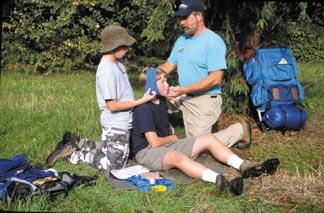 |
|
| Issue #96 • November/December, 2005 |
Frostbite can be defined, in its most severe stage, as when your fingers and toes freeze and have to be cut off because of gangrene. Wow, talk about drastic. Well, this is the extreme, but it can happen.
Being frostbitten is serious and can happen even when the actual temperature is above freezing. Wind chill or rapid movement through cold air (skiing, snowmobiling, and the like) can create a freezing effect on exposed skin, and the result is frostbite.
This condition occurs when body tissue is injured by exposure to intense cold for a period of time, and circulation slows or stops. Usually the fingers, toes, and ears are first affected, but the nose, cheeks, hands, and feet are also susceptible to frostbite. This is accelerated if the body parts are wet (or even moist) and nothing is done to re-warm them and restore circulation.
If the condition is allowed to persist for any length of time, ice crystals can actually form in the cells of the tissue.
At the first sign of this condition, get out of the cold, drink something hot, and slowly warm the affected areas with tepid (not hot) water. Frostbitten flesh should not be rubbed, as was the suggestion in the past. However, in order to improve the circulation, the temperature of the affected tissue must rise.
In severe cases of frostbite, victims will develop blisters on the frostbitten areas. Do not break the blisters. In this state, the skin will probably appear gray or white, and the need for medical assistance is immediate. Gangrene can result. This is when a victim has the potential of irreversible damage that can lead to amputation.
In the case of severe frostbite, the “immersion method” of treatment is the most effective. Place the affected extremity in water maintained at slightly more than 100 degrees Fahrenheit. This should continue until the affected area is completely thawed and normal color returns. The thawing period will usually bring teeth-clenching pain and severe tingling. However, elevating the affected area can help reduce these sensations until the circulation has been restored.
The sooner the warming process is started for a frostbite victim, the less chance of permanent damage being done. Actually, as soon as any frostbite symptom occurs, seek medical attention if at all possible.
Of course, this is easier said than done if you are out in the elements. That’s when you seek cover under an evergreen tree and build a warming fire.
For any of us who might have had a mild case of frostbite to the ears and fingersat any time in our livesthe burning and itching sensations have a tendency to recur when these same areas are again subjected to the cold (or even heat). Ear and finger exposure to intense cold is painful (we speak from experience).
There are more or less three stages of frostbite. The first is a redness of the skin, along with pain and a stinging sensation. The second is when numbness sets in. The last and most dangerous stage is when the tissue itself begins to freeze.
You don’t avoid frostbite; you prevent it. Common sense is the key. Frostbite should not be taken lightly.
Layer your winter clothing, and make sure your ears are covered. You can work wonders with ear muffs and a scarf. In below-freezing weather, shield your cheeks and nose as well.
To protect your fingers, make sure you have good gloves or mittens. The tips of the fingers are usually the first to feel the burning sensation of frostbite.
Warm, dry socks are needed to insulate your toes and feet, and make sure your footwear is waterproof.
When selecting your clothing, remember wool is the only fabric that keeps you warm even when it’s wet.
Whenever venturing into situations where the danger of cold and frostbite exists, there are four essential items to bring along: Always carry an extra pair of gloves, an extra pair of warm socks, a ski mask, and a supply of waterproof matches or a dependable lighter. Building a warming fire could save a life. These items could be invaluable in staving off the possibility of frostbite if you find yourself in the wrong outdoor situation.
However, a little hot chocolate on a wintry day might be a good idea even if you aren’t suffering frostbite.














